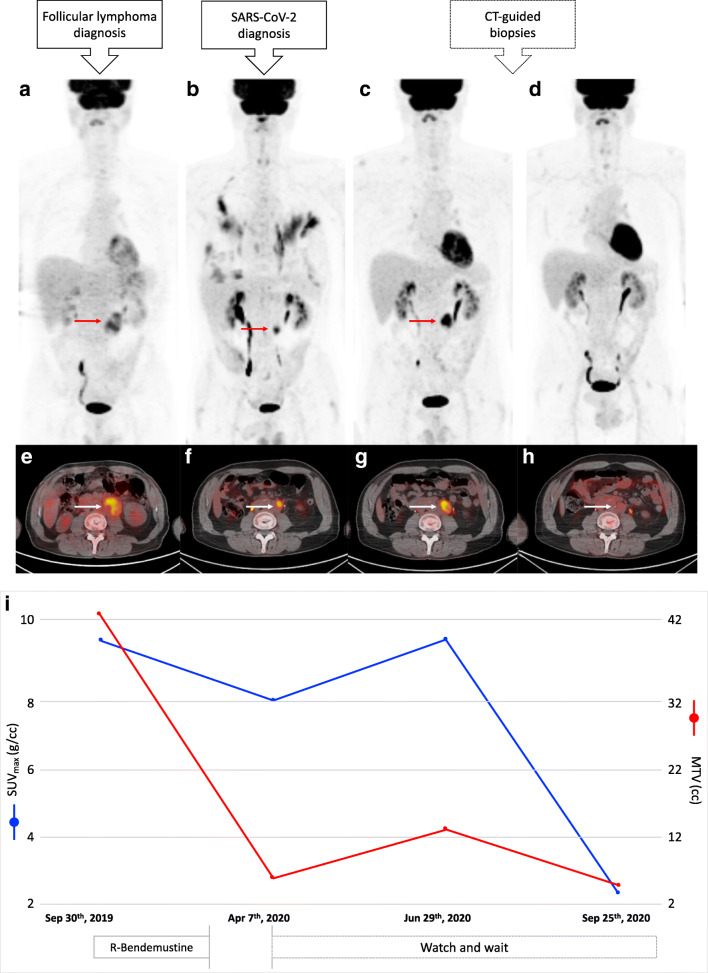In a 61-year-old patient affected from follicular lymphoma, end-of-treatment [18F]FDG-PET/CT (panel B) revealed bilateral pneumonia suggestive for COVID-19, subsequently confirmed by a nasal swab. Simultaneously, images showed the shrinkage of a para-aortic lymph nodal lesion compared to baseline (arrows), consistent with a partial response to R-bendamustine (panels B–F vs A–E). Re-staging [18F]FDG-PET/CT, obtained after SARS-CoV-2 recovery, showed an increase in size and in [18F]FDG avidity of the para-aortic lesion, suggestive for progressive disease (panels C-G-I). During COVID-19 infection and after, he did not experience any symptoms [1]. Surprisingly, malignancy was excluded by CT-guided biopsy performed twice, and this finding was confirmed by a second follow-up scan showing a complete metabolic response (panels D–H).
Complete remission after a concurrent infection has been reported in diffuse large B-cell lymphoma [2] and Hodgkin lymphoma [3].
The SARS-CoV-2 infection has proved to trigger an immune response. In this patient, the virus may have firstly induced a local “flare phenomenon” (panels C-G-I)—as typically observed in patients receiving immunotherapy—finally resulting in an “abscopal effect” (panels D–H). This report suggests a close interplay among COVID-19 infection, inflammation, and tumour biology.
Code availability
Not applicable.
Author contribution
AC and MS conceptualized the paper; FG and CCS managed the patient; MS and FG collected clinical data and images; AC, MS, and CCS critically interpreted results; MS drafted the paper. All the authors critically revised the paper and approved the submitted version of the manuscript.
Data availability
The manuscript represents valid work. Arturo Chiti had full access to all the data and takes responsibility for the data integrity and the accuracy of the data analysis.
Declarations
Ethics approval
Not applicable.
Consent to participate and consent for publication
Written informed consent was obtained from the patient for anonymous data publication.
Conflict of interest
Prof. Chiti reports a fellowship grant from Sanofi and personal fees from AAA, Blue Earth Diagnostics, and General Electric Healthcare, outside the submitted work. The other authors do not report any conflict of interest.
Footnotes
This article is part of the Topical Collection on Infection and inflammation.
Publisher’s note
Springer Nature remains neutral with regard to jurisdictional claims in published maps and institutional affiliations.
References
- 1.Sollini M, Gelardi F, Chiti. Asymptomatic versus symptomatic patients: [18F]FDG-PET/CT patterns and evolutionary track of COVID-19 associated vasculitis. Beyond Rheumatol. 2020.
- 2.Buckner TW, Dunphy C, Fedoriw YD, Van Deventer HW, Foster MC, Richards KL, et al. Complete spontaneous remission of diffuse large B-cell lymphoma of the maxillary sinus after concurrent infections. Clin Lymphoma, Myeloma Leuk. 2012. [DOI] [PubMed]
- 3.Challenor S, Tucker D. SARS-CoV-2-induced remission of Hodgkin lymphoma. Br J Haematol. 2021. [DOI] [PubMed]
Associated Data
This section collects any data citations, data availability statements, or supplementary materials included in this article.
Data Availability Statement
The manuscript represents valid work. Arturo Chiti had full access to all the data and takes responsibility for the data integrity and the accuracy of the data analysis.



